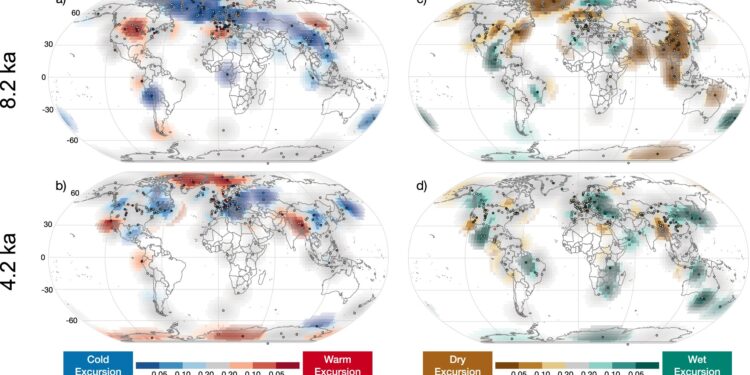Spatial expression of the 8.2 and 4.2 ka climate excursions. Credit: Nature Communications (2024). DOI: 10.1038/s41467-024-50886-w
4,200 years ago, a massive drought had catastrophic consequences, potentially wiping out early empires and causing massive changes across the globe. It was so severe that it marked a turning point in Earth’s geological history.
Or was it?
New research from Northern Arizona University shows that while the 4.2K-year event did occur, its consequences may not have been as catastrophic on a global scale as previously thought. In fact, it may have been just one of many varied climate events during the Holocene epoch, which began about 11,700 years ago.
The study, published in Nature Communicationsis unique not only for its surprising results, but also for the way it was developed. Faced with more than 1,000 data sets, NAU faculty created a graduate class that allowed students to participate in the research. The paper’s dozen co-authors range from NAU faculty to students to alumni who have participated for multiple years.
“In 2018, this event was used as a new geological marker to subdivide our current geological epoch, the Holocene,” said lead author Nicholas McKay, associate professor in the School of Earth and Sustainability. “This was a good motivation to look further into the large-scale evidence for this event, because we weren’t even sure it was a real event, let alone something that should be used as a global marker.”
Marshall, Cody Routson, Dave Edge, Chris Hancock, Georgia Roberts, Michael Erb, Maurycy Zarczynski, Darrell Kaufman and Hannah Kolus. Missing from photo: Nick McKay. Credit: Northern Arizona University
Finding the climate needle in the famous haystack
The answers to these questions lay in 12,000 years of climate data spanning the globe. The research team had to figure out how to analyze it.
The team developed an improved method to objectively detect and assess the significance of climate events in paleoclimate data, enabling a comprehensive examination of temperature and water changes throughout the Holocene.
As researchers looked through the data, a new narrative emerged: While the effects of the 4.2-million-year-old megadrought were present in some places, they weren’t present everywhere. Even when researchers observed effects that could be attributed to the event, those effects looked different.
They didn’t observe a single major event that changed everything, but rather a series of smaller events that impacted the local climate. Many places experienced climate changes during this period, McKay said, but these changes were no more widespread or significant than those that occurred at other times in the Holocene.
The team found few significant events outside of the 4.2K-year event. There was the well-known 8.2K-year event, a pronounced cold and dry period centered over the North Atlantic. There were also significant temperature changes during the Christian era, consistent with the medieval cold period and the medieval climate anomaly.
The main lesson from this experiment is that abrupt changes in temperature and precipitation were common at local scales throughout the Holocene, and globally coherent events were rare. The other major lesson from this experiment is the importance of rigorous, data-driven approaches to understanding past climate variability.
“This research challenges the use of the 4.2K-year event as a global geological marker and provides a cautionary tale in interpreting local climate change as globally significant,” said co-author Leah Marshall, a doctoral student in earth sciences and environmental sustainability.
“Our results show that climate excursions have occurred throughout the Holocene, and a better understanding of the timing, patterns, and causes of these abrupt change events is important for future climate modeling projects.”
What this means for the future
The research was aimed at providing a better understanding of the past, but the results are much more important than that: knowing how the climate has changed over the millennia could help scientists understand how it will change in the future.
“This study suggests that natural climate changes can occur on a century-scale (200 to 400 years) in some regions, but not on a global scale,” McKay said. “These natural changes are different from the massive changes caused today by human-caused carbon dioxide emissions, but the future climate will be a combination of these natural changes and human-caused changes, and it is important that we understand both.”
The researchers published their analysis methods so that future research can process these large data sets to study past climate. Overall, what came out of the class is worth more than a grade for students.
“What made this course exciting was being able to participate in discussions about such a large dataset and learning more about how these synthesis studies are designed,” Marshall said. “This was new to me, as my research has typically focused on single sites. With such a large dataset and the new toolkit developed by the co-authors, there are a lot of interesting questions to ask.”
More information:
Nicholas P. McKay et al., The 4.2 ka event is not remarkable in the context of Holocene climate variability, Nature Communications (2024). DOI: 10.1038/s41467-024-50886-w
Provided by Northern Arizona University
Quote:Study finds impacts of 4.2k km climate event not really significant (2024, August 16) retrieved August 16, 2024 from
This document is subject to copyright. Apart from any fair dealing for the purpose of private study or research, no part may be reproduced without written permission. The content is provided for informational purposes only.



